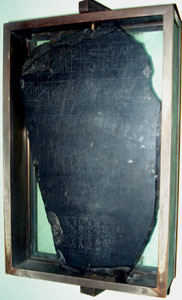
The Palermo Stone (more correctly known as the Royal Annals) is one of the most important primary sources in the study of ancient Egyptian history. The exact date of the stone’s creation is in doubt, but it is thought to have been towards the end of the fifth dynasty (Old Kingdom in the twenty-fifth century B.C.).
The Palermo Stone lists the mythical predynastic kings of Egypt followed by the pharaohs of the first five dynasties. It records information on taxation, religious ceremonies, the levels of the Nile, building works, trade and military expeditions during this early period of Egyptian history making it the world’s oldest history book. It was one of the primary sources from which Manetho compiled his history of Egypt.
It is composed of black basalt and it is estimated that the Palermo Stone was around two metres high when complete, but unfortunately its significance was not immediately recognised, and at one point it was allegedly used as a door stop! Only a few fragments of the stone have been recovered and many are badly damaged. There remains some doubt about whether all of the fragments are indeed part of the same piece, and there is dispute over the translation of sections of the text.
The stone takes its name from the Palermo Archaeological Museum in Sicily where one of the largest fragments is housed. Other fragments can be seen in the Egyptian Museum in Cairo, and the Petrie Museum in London.

The information on the Palermo stone is corroborated by a number of ebony labels found scattered around Saqqara, Abydos, and other ancient sites. These labels contain some information omitted from the fragments of the stone that we have recovered, and the stone itself records information not covered by the labels so despite the inclusion of the mythical kings, it is considered to be relatively accurate.
The Palermo stone records the construction of a stone building called Men-netjeret during the reign of Khasekhemwy or Nebka which predates the Step Pyramid of Djoser making it the world’s first stone building. It is often suggested that this building is the unfinished structure now known as Gisr el-Mudir at Saqqara.
The Palermo Stone confirms that the ancient Egyptians had already developed the technology to smelt copper and create copper statues by the Second dynasty and it records a trading mission to an unnamed exotic land during the reign of Sneferu which returned with forty ships bearing precious wood and mining expeditions to Sinai to quarry turquoise. The stone also records military expeditions by Den to the east and by Sneferu to Nubia and Libya
Bibliography
- Ancient Egypt (1991) Barry J. Kemp
- An Introduction to the Archeology of Ancient Egypt (2008) Kathryn A. Bard
- “The Emergence of the Egyptian State”, K Bard and “The Old Kingdom”, J Malek in The Oxford History of Ancient Egypt (2000) Ed I. Shaw
Copyright J Hill 2015